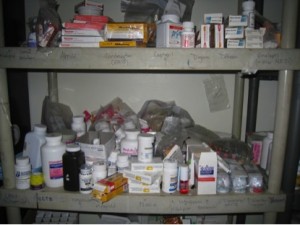Sport and Exercise Medicine: The UK trainee perspective (A BJSM blog series)
By Stefan Kluzek and Rose Penfold
 UK sports grounds typically have a stock of emergency medications, supplied and prescribed by a club doctor. Recently, a physiotherapy colleague told me that Professional Sport Association pitch- side trainers informed her that medications, especially emergency medications, should always be readily accessible, especially when the doctor is not available. Since this raises issues regarding professional standards and duty of care, I resolved to investigate current legal frameworks protecting both medical personnel and athlete in the athletic arena.
UK sports grounds typically have a stock of emergency medications, supplied and prescribed by a club doctor. Recently, a physiotherapy colleague told me that Professional Sport Association pitch- side trainers informed her that medications, especially emergency medications, should always be readily accessible, especially when the doctor is not available. Since this raises issues regarding professional standards and duty of care, I resolved to investigate current legal frameworks protecting both medical personnel and athlete in the athletic arena.
Preliminary research highlights that there is no specific guidance on medical provision at sports grounds, especially during training. I proceeded to contact the Care Quality Commission (CQC), Sports Grounds Safety Authority (SGSA), UK Anti-Doping (UKAD), General Medical Council (GMC) and the Medical Protection Society (MPS). The Health and Social Care Act 2008, which established the CQC, does not extend to cover sports training facilities. The SGSA, whilst playing a critical role in overseeing the safety of spectators, has no remit concerning athletes. UKAD does not have a policy on this and merely recommends that doctors follow existing guidance regarding access to controlled substances. The GMC have not published any specific guidelines nor (as far as I could determine) articles; however, they suggest that similar rules apply to medications kept at any facility and referred me to their following core guidance1:
- Good medical practice (2013), paragraph 12: “You must…follow the law, our guidance and other regulations relevant to your work.”
- Good practice in prescribing and managing medicines and devices (2013), paragraph 6: “You must maintain and develop knowledge and skills in…prescribing and medicines management relevant to your role.”
- And paragraph 51: “…you must make sure that arrangements are in place for monitoring, follow-up and review, taking account of patients’ needs and any risks arising from the medicines.”
Assuming sports grounds are no different to other healthcare facilities, if we do not uphold these standards we risk compromising the quality of pitch-side care. Security and record-keeping should be monitored to ensure all drugs are in-date, correctly stored and appropriately administered by qualified professionals. A risk assessment for the sports ground environment should be conducted every time one supplies new medication. The CQC have published on-line a self-assessment tool for primary care providers and acute NHS trusts or independent hospitals – perhaps a means by which club doctors can monitor their current practice2.
Legal frameworks do exist allowing physiotherapists to prescribe medication: namely, Patient Group Directions (PGDs), Patient Specific Directions and Supplementary Prescribing. These legislations are “reserved solely for situations where they offer an advantage for patient care (without compromising safety), and where it is consistent with appropriate professional relationships and accountability”. Whether this applies here is controversial. PGDs, for instance, cannot be written in the private healthcare sector unless the organisation is CQC-registered. Supplementary prescribing is undertaken in NHS environments where a multidisciplinary team develops a Therapeutic Care Plan for a patient; again, not really applicable here. Interestingly, last year the Department of Health published a Summary of Public Consultation on Proposals to Introduce Independent Prescribing by Physiotherapists3 – of 689 total responses, 99% were in support. If there is a move towards independent prescribing by physiotherapists in the future, this may resolve the dilemma as responsibility for prescription and use of medication will fall to each individual.
To conclude, this remains a legislative grey area and, from personal experience, this extends into clinical practice. Whilst it may not be a problem for Premiership clubs (where medically-qualified personnel are always present), lower-division clubs may find themselves in difficult situations. Approved and accredited pitch-side trauma courses have been improving pitch-side standards of emergency care in recent times. It seems logical, therefore, that adequately trained and competency-assessed individuals should have access to medications to use in the situations they have been trained for. By law4, employers are obligated to protect the health, safety and welfare of employees; this includes athletes in their occupational environment. As a group, are we prepared to self-regulate by enforcing the standards of other healthcare facilities, or is it time for professional bodies to produce some official, pragmatic guidelines? Ultimately, protection of athlete safety at the sports ground is our moral and professional responsibility.
I eagerly await opinions on this issue.
References
4Health and Safety Executive, Health and Safety Law
**********************************************
Dr Stefan Kluzek MRCP (UK) MRCP(London) DipSEM is a Sport and Exercise Medicine Registrar in the Oxford Deanery. He is a Clinical Research Fellow in Sport and Osteoarthritis at Oxford University. He is also the Medical Officer to Oxford University Rugby FC and Medical Officer at Oxford RL.
Rose Penfold is a 4th year Medical Student at Oxford University.
Dr James Thing co-ordinates “Sport and Exercise Medicine: The UK trainee perspective” monthly blog series.